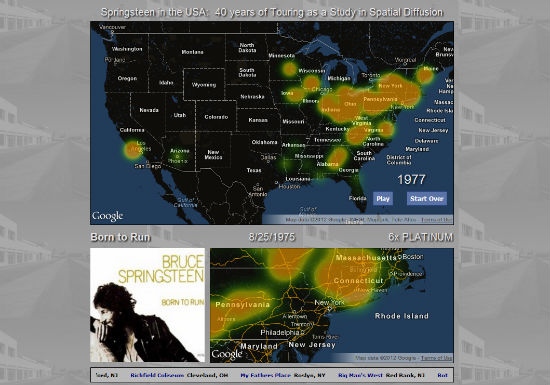Springsteen in the USA: 40 Years of Touring as a Study in Spatial Diffusion
There’s no more persuasive evidence that we’re in the twilight of the “Rock Star” than its appropriation by the tech sector to mean little more than someone with a penchant for wearing black and an inflated self-regard. But there are still a few true rock stars still plying their craft, including Bruce Springsteen who, in his 40th year touring as a major-label artist, is criss-crossing the US in support Wrecking Ball, his latest record, album, melange of mp3 tracks.
Though Kennedy Center honors and long New Yorker profiles threaten to enbalm him in Icon Emeritus status, the current 3½ hour shows he’s doing now are as much about the loud, vital present as reflections on the passage of the decades. As a geographer, 1500+ shows over 40 years is an opportunity to map Springsteen’s career as a study in spatial diffusion–how phenomena such as innovation, fashion, or disease spread geographically. Except in this case the contagion is rock ‘n roll:

To understand what you’re seeing in the YouTube video above, keep the following in mind:
- each red dot is a performance (data courtesy of the Killing Floor database)
- the intensity or “heat” generated is a function of the location of a show, the size of the venue, and inversely correlated with the overall population within 40km of the concert location. So for instance, a single arena show in New York City will generate less heat than a single arena show in Omaha, NE
- there is a tapering effect applied so returning to a particular area within a few months will reflect a cumulative heat effect (**Click here for interactive map version)
Here are some of the things I observe–
Two Advantages of Starting Out in Central New Jersey
From strictly a population geography standpoint, in the early 1970s you couldn’t do better than being equidistant between New York City (largest city) and Philadelphia (#4): over 20 million souls within a two-hour drive. Just as important, the Jersey Shore provided a unique, accessible symbolic resonance to audiences that resonates as a Place. (In stark contrast to the way a million bands from Brooklyn today fail to convince the rest of us of the intrinsic awesomeness of…Brooklyn.)
How To Go Viral In the Pre-Internet Era
The persistence of Springsteen’s popularity along the I-95/I-80 axes has its origin in racking up serious mileage on the college gym circuit (Stony Brook, Grinnell, Niagara, Widener, et al). In larger cities, as was more of the custom back in the day, he often played a couple a shows a night for multiple nights in a row. Think of the difference in the word-of-mouth impact when someone gushes over an unknown act they saw the night before: today you might file it away and hope to catch them the next time they’re in town months down the road, back then he was still around playing shows for the rest of the week.
And if you’re staking the success of your band on the power of your live show don’t be the opening act. Better to headline a smaller venue than to tag along as the opener in a larger venue.
Big Hits Trigger Hierarchical Diffusion
We can see both on the map, as well as record sales, three notable inflection points in Springsteen’s career:
- “Born To Run” in 1975 was the spring-board to being a truly national, with the follow-on records “Darkness..” and “The River” consolidating his status as a successful arena act.
- “Born in The USA” in 1984 was his monster disc where you see the clearest distinction between ordinary expansion diffusion and hierarchical diffusion, where a mass phenomenon readily hops among large population concentrations less impeded by mere distance.
- “The Rising” in 2002 saw the combination of very strong new material and the pent-up demand for a recently-reunited E Street Band result in a strong slate of both arena shows as well as stadium dates. It also added a younger cohort of fans to the ever-loyal “base” that have made successive tours more vibrant than mere exercises in Baby Boomer nostalgia.
* * * * * *
In the broader context of 500 years of a Western culture becoming ever more individualistic, its major creeds increasingly more domesticated, the rock concert as an intense celebration of communal emotion is an echo of a type of religious expression many, many centuries old. Indeed, what was following the Grateful Dead or Phish from city-to-city other than a contemporary analog of medieval pilgrimage? Only from the cramped perspective of pop culture’s fixation on youth is a Bruce Springsteen or Leonard Cohen (77 years old and still doing four-encore 2½ hour shows) commanding the stage an oddity: our ancient forebears would immediately recognize that it’s the wise-man/shaman/entertainer who is best equipped to channel both what the audience wants to hear and what it needs to hear.
—Brian Timoney
UPDATE (9/14/2012): Nice shout-out from the Washington Post Wonkblog.
* * * * * *



Daniel Trone created the animated heat map. Details about making the map here
Tour dates courtesy of Paolo Calvi’s Killing Floor database
10th Avenue Freeze-out background track courtesy of this
And a special shout-out to my sister Judy who took the teenaged me to my first Springsteen show at The Spectrum in Philadelphia and treated the 40-year old me 25 years later to the very top row of Giants Stadium.